ACC60008 Accounting Systems: Blackmores Limited Performance Report
VerifiedAdded on 2023/05/06
|21
|5141
|201
Report
AI Summary
This report provides a comprehensive analysis of Blackmores Limited's business performance over a three-year period, evaluating its profitability, efficiency, liquidity, solvency, and share market performance. The analysis reveals a downward trend in profitability, impacted by COVID-19, regulatory changes in China, and relabeling requirements, despite ongoing investments in the business, including the acquisition of a new facility. Blackmores strengthened its liquidity and solvency through a share capital raising and institutional placement in 2020. While the share price has been volatile, the report recommends a hold strategy for shareholders in the short-term, with a potential buy opportunity for long-term investors, emphasizing the positive long-term outlook for Blackmores despite short-term uncertainties. The report also compares Blackmores' financial ratios with its market peer, Probiotec, to assess its performance.
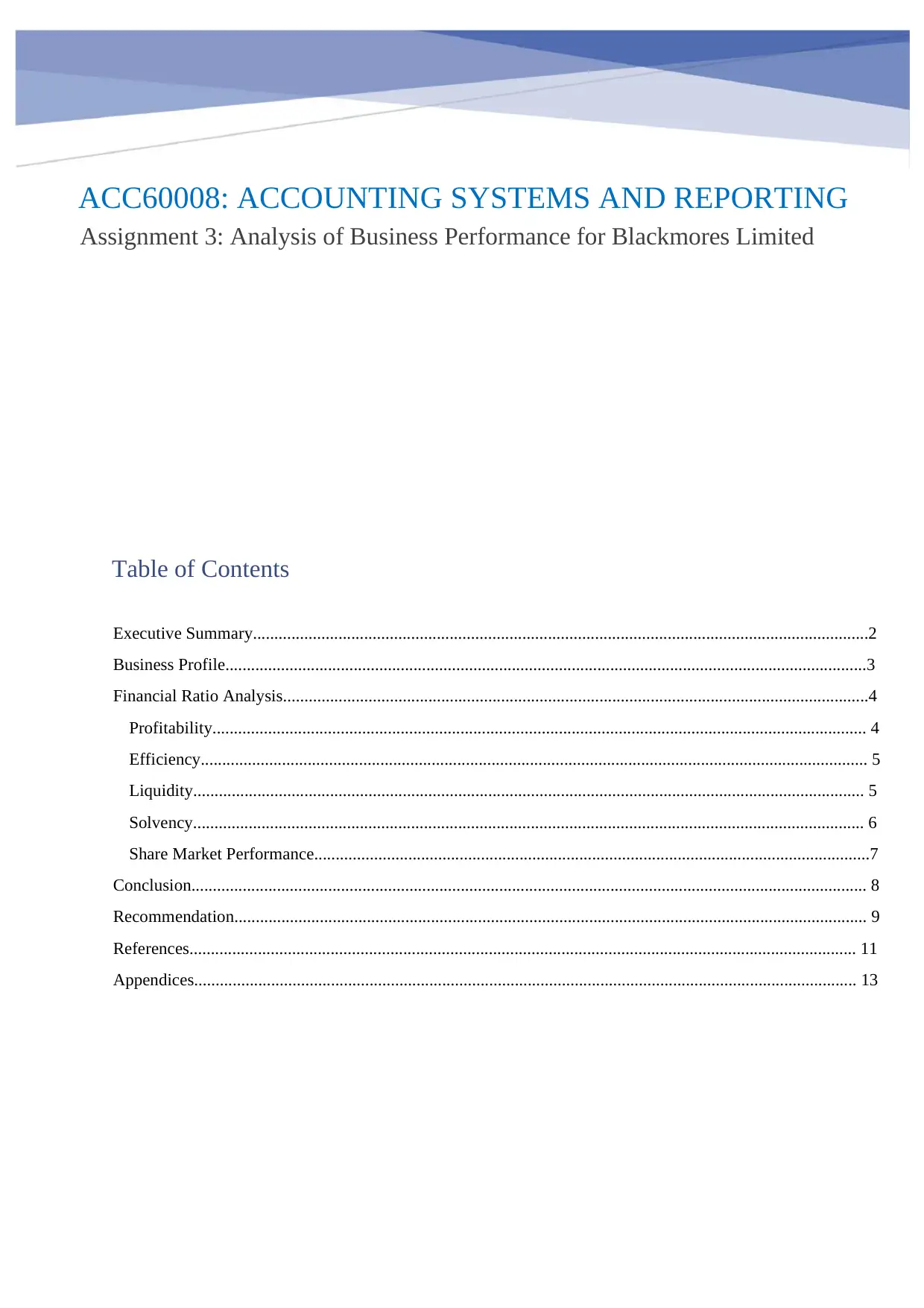
ACC60008: ACCOUNTING SYSTEMS AND REPORTING
Assignment 3: Analysis of Business Performance for Blackmores Limited
Table of Contents
Executive Summary................................................................................................................................................2
Business Profile......................................................................................................................................................3
Financial Ratio Analysis.........................................................................................................................................4
Profitability......................................................................................................................................................... 4
Efficiency............................................................................................................................................................ 5
Liquidity............................................................................................................................................................. 5
Solvency............................................................................................................................................................. 6
Share Market Performance..................................................................................................................................7
Conclusion.............................................................................................................................................................. 8
Recommendation.................................................................................................................................................... 9
References............................................................................................................................................................ 11
Appendices........................................................................................................................................................... 13
Assignment 3: Analysis of Business Performance for Blackmores Limited
Table of Contents
Executive Summary................................................................................................................................................2
Business Profile......................................................................................................................................................3
Financial Ratio Analysis.........................................................................................................................................4
Profitability......................................................................................................................................................... 4
Efficiency............................................................................................................................................................ 5
Liquidity............................................................................................................................................................. 5
Solvency............................................................................................................................................................. 6
Share Market Performance..................................................................................................................................7
Conclusion.............................................................................................................................................................. 8
Recommendation.................................................................................................................................................... 9
References............................................................................................................................................................ 11
Appendices........................................................................................................................................................... 13
Paraphrase This Document
Need a fresh take? Get an instant paraphrase of this document with our AI Paraphraser
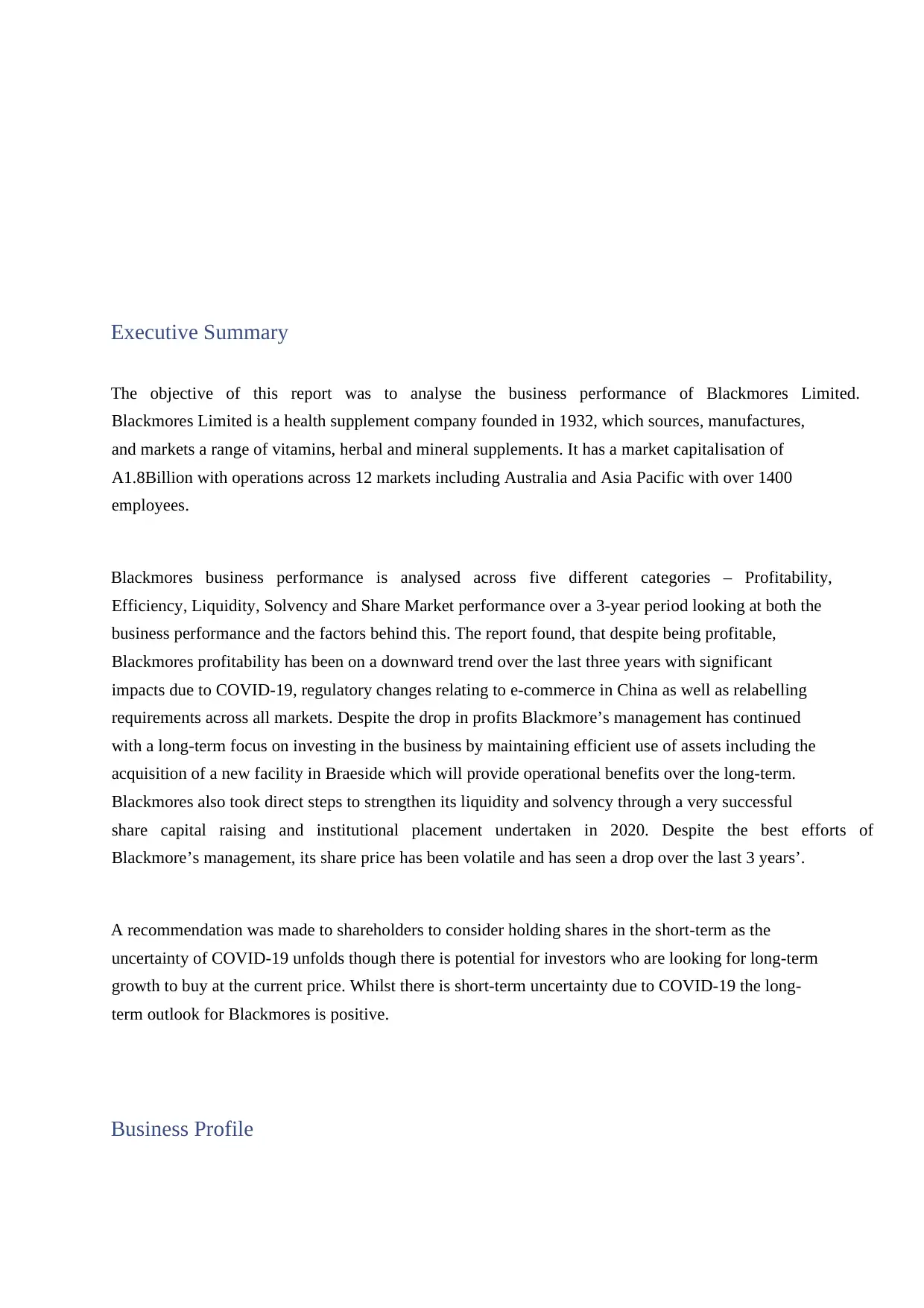
Executive Summary
The objective of this report was to analyse the business performance of Blackmores Limited.
Blackmores Limited is a health supplement company founded in 1932, which sources, manufactures,
and markets a range of vitamins, herbal and mineral supplements. It has a market capitalisation of
A1.8Billion with operations across 12 markets including Australia and Asia Pacific with over 1400
employees.
Blackmores business performance is analysed across five different categories – Profitability,
Efficiency, Liquidity, Solvency and Share Market performance over a 3-year period looking at both the
business performance and the factors behind this. The report found, that despite being profitable,
Blackmores profitability has been on a downward trend over the last three years with significant
impacts due to COVID-19, regulatory changes relating to e-commerce in China as well as relabelling
requirements across all markets. Despite the drop in profits Blackmore’s management has continued
with a long-term focus on investing in the business by maintaining efficient use of assets including the
acquisition of a new facility in Braeside which will provide operational benefits over the long-term.
Blackmores also took direct steps to strengthen its liquidity and solvency through a very successful
share capital raising and institutional placement undertaken in 2020. Despite the best efforts of
Blackmore’s management, its share price has been volatile and has seen a drop over the last 3 years’.
A recommendation was made to shareholders to consider holding shares in the short-term as the
uncertainty of COVID-19 unfolds though there is potential for investors who are looking for long-term
growth to buy at the current price. Whilst there is short-term uncertainty due to COVID-19 the long-
term outlook for Blackmores is positive.
Business Profile
The objective of this report was to analyse the business performance of Blackmores Limited.
Blackmores Limited is a health supplement company founded in 1932, which sources, manufactures,
and markets a range of vitamins, herbal and mineral supplements. It has a market capitalisation of
A1.8Billion with operations across 12 markets including Australia and Asia Pacific with over 1400
employees.
Blackmores business performance is analysed across five different categories – Profitability,
Efficiency, Liquidity, Solvency and Share Market performance over a 3-year period looking at both the
business performance and the factors behind this. The report found, that despite being profitable,
Blackmores profitability has been on a downward trend over the last three years with significant
impacts due to COVID-19, regulatory changes relating to e-commerce in China as well as relabelling
requirements across all markets. Despite the drop in profits Blackmore’s management has continued
with a long-term focus on investing in the business by maintaining efficient use of assets including the
acquisition of a new facility in Braeside which will provide operational benefits over the long-term.
Blackmores also took direct steps to strengthen its liquidity and solvency through a very successful
share capital raising and institutional placement undertaken in 2020. Despite the best efforts of
Blackmore’s management, its share price has been volatile and has seen a drop over the last 3 years’.
A recommendation was made to shareholders to consider holding shares in the short-term as the
uncertainty of COVID-19 unfolds though there is potential for investors who are looking for long-term
growth to buy at the current price. Whilst there is short-term uncertainty due to COVID-19 the long-
term outlook for Blackmores is positive.
Business Profile
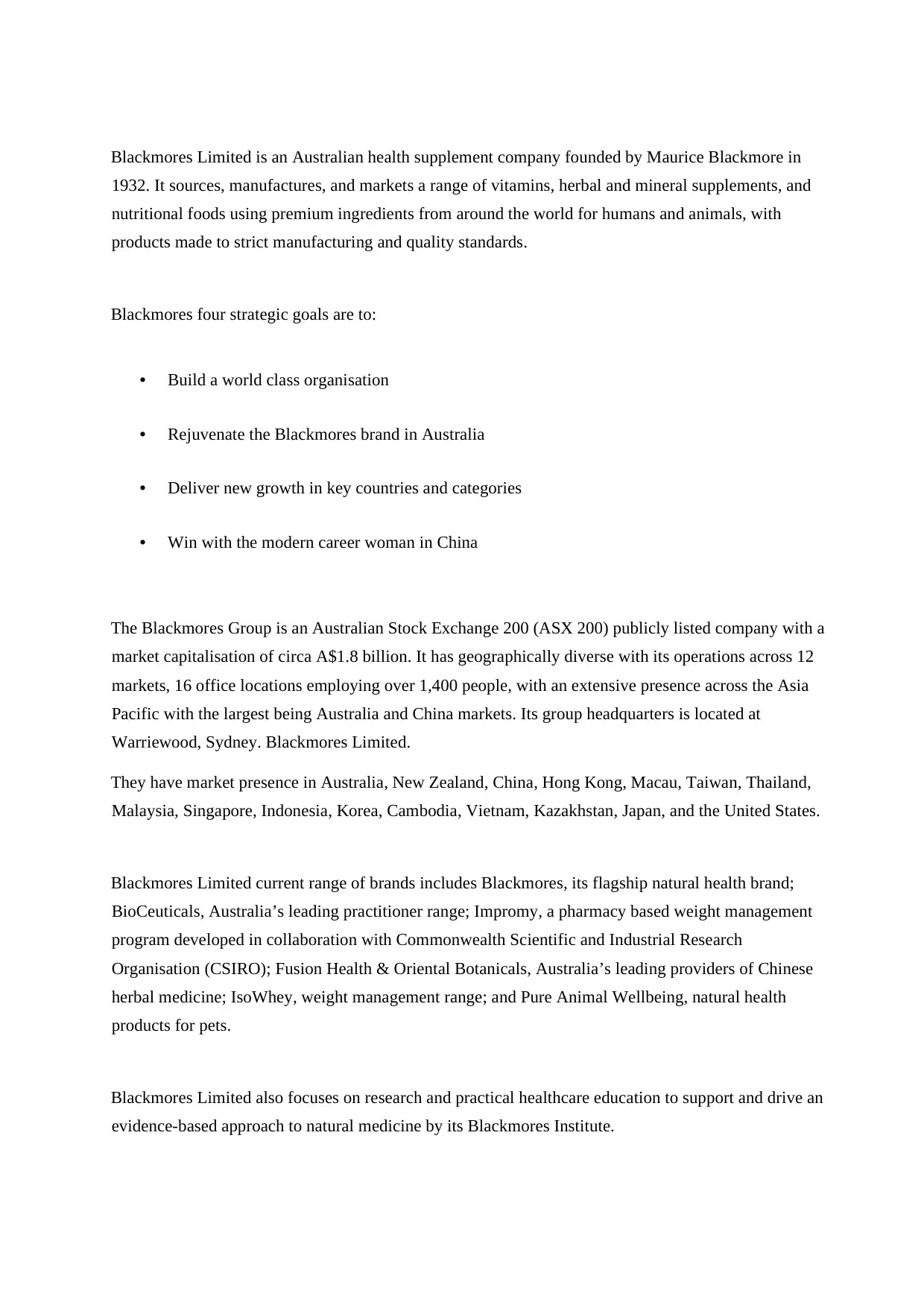
Blackmores Limited is an Australian health supplement company founded by Maurice Blackmore in
1932. It sources, manufactures, and markets a range of vitamins, herbal and mineral supplements, and
nutritional foods using premium ingredients from around the world for humans and animals, with
products made to strict manufacturing and quality standards.
Blackmores four strategic goals are to:
• Build a world class organisation
• Rejuvenate the Blackmores brand in Australia
• Deliver new growth in key countries and categories
• Win with the modern career woman in China
The Blackmores Group is an Australian Stock Exchange 200 (ASX 200) publicly listed company with a
market capitalisation of circa A$1.8 billion. It has geographically diverse with its operations across 12
markets, 16 office locations employing over 1,400 people, with an extensive presence across the Asia
Pacific with the largest being Australia and China markets. Its group headquarters is located at
Warriewood, Sydney. Blackmores Limited.
They have market presence in Australia, New Zealand, China, Hong Kong, Macau, Taiwan, Thailand,
Malaysia, Singapore, Indonesia, Korea, Cambodia, Vietnam, Kazakhstan, Japan, and the United States.
Blackmores Limited current range of brands includes Blackmores, its flagship natural health brand;
BioCeuticals, Australia’s leading practitioner range; Impromy, a pharmacy based weight management
program developed in collaboration with Commonwealth Scientific and Industrial Research
Organisation (CSIRO); Fusion Health & Oriental Botanicals, Australia’s leading providers of Chinese
herbal medicine; IsoWhey, weight management range; and Pure Animal Wellbeing, natural health
products for pets.
Blackmores Limited also focuses on research and practical healthcare education to support and drive an
evidence-based approach to natural medicine by its Blackmores Institute.
1932. It sources, manufactures, and markets a range of vitamins, herbal and mineral supplements, and
nutritional foods using premium ingredients from around the world for humans and animals, with
products made to strict manufacturing and quality standards.
Blackmores four strategic goals are to:
• Build a world class organisation
• Rejuvenate the Blackmores brand in Australia
• Deliver new growth in key countries and categories
• Win with the modern career woman in China
The Blackmores Group is an Australian Stock Exchange 200 (ASX 200) publicly listed company with a
market capitalisation of circa A$1.8 billion. It has geographically diverse with its operations across 12
markets, 16 office locations employing over 1,400 people, with an extensive presence across the Asia
Pacific with the largest being Australia and China markets. Its group headquarters is located at
Warriewood, Sydney. Blackmores Limited.
They have market presence in Australia, New Zealand, China, Hong Kong, Macau, Taiwan, Thailand,
Malaysia, Singapore, Indonesia, Korea, Cambodia, Vietnam, Kazakhstan, Japan, and the United States.
Blackmores Limited current range of brands includes Blackmores, its flagship natural health brand;
BioCeuticals, Australia’s leading practitioner range; Impromy, a pharmacy based weight management
program developed in collaboration with Commonwealth Scientific and Industrial Research
Organisation (CSIRO); Fusion Health & Oriental Botanicals, Australia’s leading providers of Chinese
herbal medicine; IsoWhey, weight management range; and Pure Animal Wellbeing, natural health
products for pets.
Blackmores Limited also focuses on research and practical healthcare education to support and drive an
evidence-based approach to natural medicine by its Blackmores Institute.
⊘ This is a preview!⊘
Do you want full access?
Subscribe today to unlock all pages.

Trusted by 1+ million students worldwide
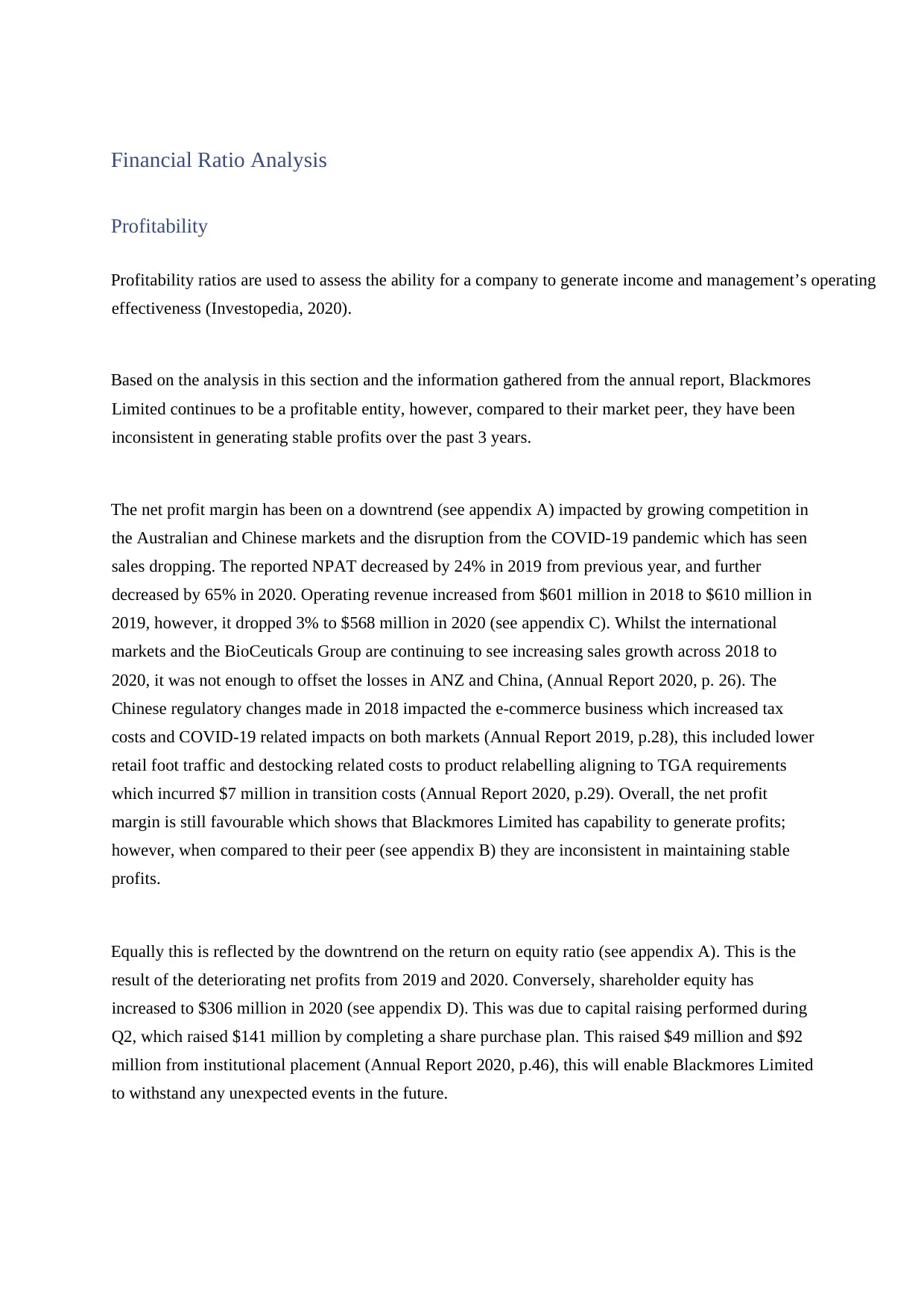
Financial Ratio Analysis
Profitability
Profitability ratios are used to assess the ability for a company to generate income and management’s operating
effectiveness (Investopedia, 2020).
Based on the analysis in this section and the information gathered from the annual report, Blackmores
Limited continues to be a profitable entity, however, compared to their market peer, they have been
inconsistent in generating stable profits over the past 3 years.
The net profit margin has been on a downtrend (see appendix A) impacted by growing competition in
the Australian and Chinese markets and the disruption from the COVID-19 pandemic which has seen
sales dropping. The reported NPAT decreased by 24% in 2019 from previous year, and further
decreased by 65% in 2020. Operating revenue increased from $601 million in 2018 to $610 million in
2019, however, it dropped 3% to $568 million in 2020 (see appendix C). Whilst the international
markets and the BioCeuticals Group are continuing to see increasing sales growth across 2018 to
2020, it was not enough to offset the losses in ANZ and China, (Annual Report 2020, p. 26). The
Chinese regulatory changes made in 2018 impacted the e-commerce business which increased tax
costs and COVID-19 related impacts on both markets (Annual Report 2019, p.28), this included lower
retail foot traffic and destocking related costs to product relabelling aligning to TGA requirements
which incurred $7 million in transition costs (Annual Report 2020, p.29). Overall, the net profit
margin is still favourable which shows that Blackmores Limited has capability to generate profits;
however, when compared to their peer (see appendix B) they are inconsistent in maintaining stable
profits.
Equally this is reflected by the downtrend on the return on equity ratio (see appendix A). This is the
result of the deteriorating net profits from 2019 and 2020. Conversely, shareholder equity has
increased to $306 million in 2020 (see appendix D). This was due to capital raising performed during
Q2, which raised $141 million by completing a share purchase plan. This raised $49 million and $92
million from institutional placement (Annual Report 2020, p.46), this will enable Blackmores Limited
to withstand any unexpected events in the future.
Profitability
Profitability ratios are used to assess the ability for a company to generate income and management’s operating
effectiveness (Investopedia, 2020).
Based on the analysis in this section and the information gathered from the annual report, Blackmores
Limited continues to be a profitable entity, however, compared to their market peer, they have been
inconsistent in generating stable profits over the past 3 years.
The net profit margin has been on a downtrend (see appendix A) impacted by growing competition in
the Australian and Chinese markets and the disruption from the COVID-19 pandemic which has seen
sales dropping. The reported NPAT decreased by 24% in 2019 from previous year, and further
decreased by 65% in 2020. Operating revenue increased from $601 million in 2018 to $610 million in
2019, however, it dropped 3% to $568 million in 2020 (see appendix C). Whilst the international
markets and the BioCeuticals Group are continuing to see increasing sales growth across 2018 to
2020, it was not enough to offset the losses in ANZ and China, (Annual Report 2020, p. 26). The
Chinese regulatory changes made in 2018 impacted the e-commerce business which increased tax
costs and COVID-19 related impacts on both markets (Annual Report 2019, p.28), this included lower
retail foot traffic and destocking related costs to product relabelling aligning to TGA requirements
which incurred $7 million in transition costs (Annual Report 2020, p.29). Overall, the net profit
margin is still favourable which shows that Blackmores Limited has capability to generate profits;
however, when compared to their peer (see appendix B) they are inconsistent in maintaining stable
profits.
Equally this is reflected by the downtrend on the return on equity ratio (see appendix A). This is the
result of the deteriorating net profits from 2019 and 2020. Conversely, shareholder equity has
increased to $306 million in 2020 (see appendix D). This was due to capital raising performed during
Q2, which raised $141 million by completing a share purchase plan. This raised $49 million and $92
million from institutional placement (Annual Report 2020, p.46), this will enable Blackmores Limited
to withstand any unexpected events in the future.
Paraphrase This Document
Need a fresh take? Get an instant paraphrase of this document with our AI Paraphraser
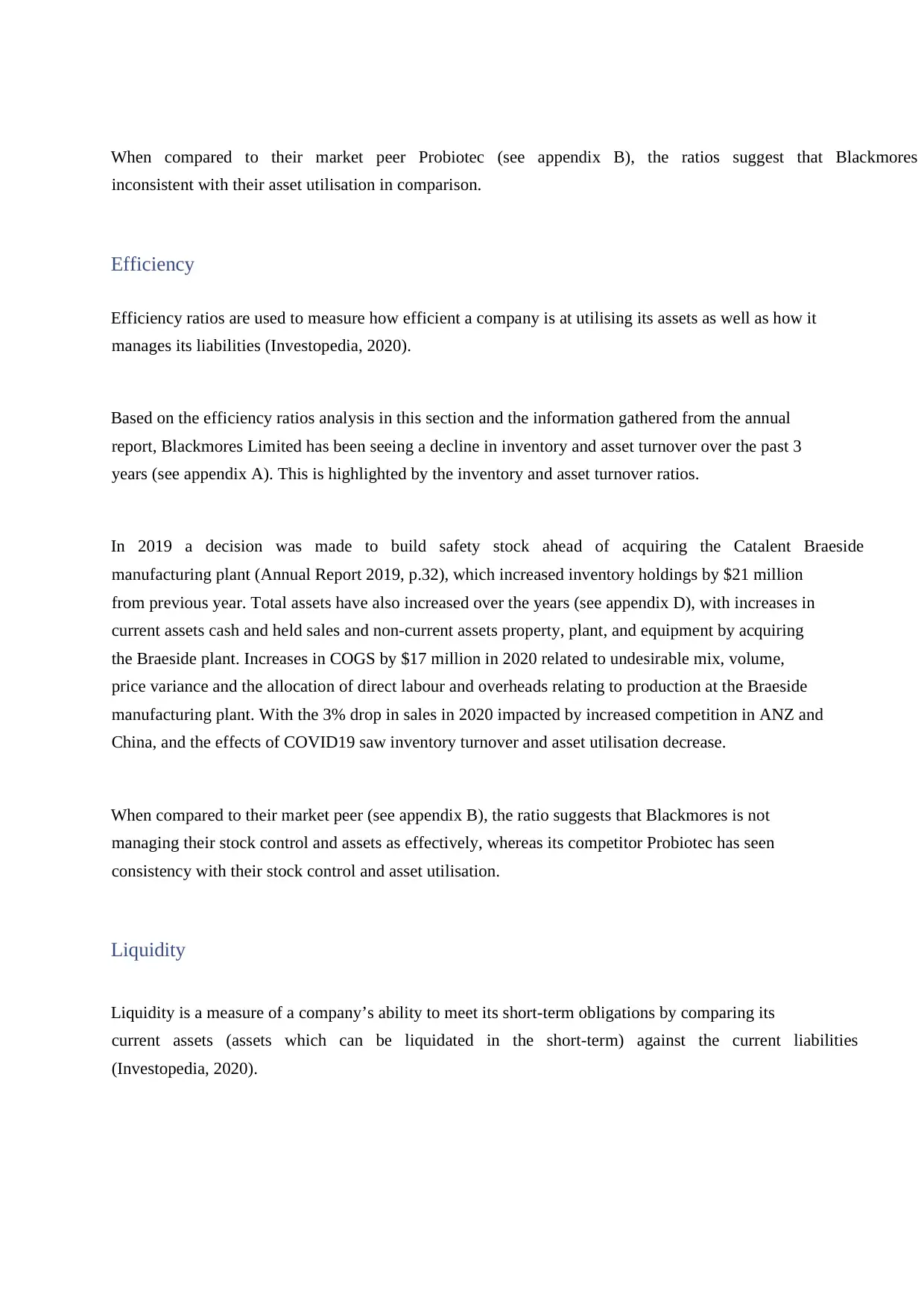
When compared to their market peer Probiotec (see appendix B), the ratios suggest that Blackmores
inconsistent with their asset utilisation in comparison.
Efficiency
Efficiency ratios are used to measure how efficient a company is at utilising its assets as well as how it
manages its liabilities (Investopedia, 2020).
Based on the efficiency ratios analysis in this section and the information gathered from the annual
report, Blackmores Limited has been seeing a decline in inventory and asset turnover over the past 3
years (see appendix A). This is highlighted by the inventory and asset turnover ratios.
In 2019 a decision was made to build safety stock ahead of acquiring the Catalent Braeside
manufacturing plant (Annual Report 2019, p.32), which increased inventory holdings by $21 million
from previous year. Total assets have also increased over the years (see appendix D), with increases in
current assets cash and held sales and non-current assets property, plant, and equipment by acquiring
the Braeside plant. Increases in COGS by $17 million in 2020 related to undesirable mix, volume,
price variance and the allocation of direct labour and overheads relating to production at the Braeside
manufacturing plant. With the 3% drop in sales in 2020 impacted by increased competition in ANZ and
China, and the effects of COVID19 saw inventory turnover and asset utilisation decrease.
When compared to their market peer (see appendix B), the ratio suggests that Blackmores is not
managing their stock control and assets as effectively, whereas its competitor Probiotec has seen
consistency with their stock control and asset utilisation.
Liquidity
Liquidity is a measure of a company’s ability to meet its short-term obligations by comparing its
current assets (assets which can be liquidated in the short-term) against the current liabilities
(Investopedia, 2020).
inconsistent with their asset utilisation in comparison.
Efficiency
Efficiency ratios are used to measure how efficient a company is at utilising its assets as well as how it
manages its liabilities (Investopedia, 2020).
Based on the efficiency ratios analysis in this section and the information gathered from the annual
report, Blackmores Limited has been seeing a decline in inventory and asset turnover over the past 3
years (see appendix A). This is highlighted by the inventory and asset turnover ratios.
In 2019 a decision was made to build safety stock ahead of acquiring the Catalent Braeside
manufacturing plant (Annual Report 2019, p.32), which increased inventory holdings by $21 million
from previous year. Total assets have also increased over the years (see appendix D), with increases in
current assets cash and held sales and non-current assets property, plant, and equipment by acquiring
the Braeside plant. Increases in COGS by $17 million in 2020 related to undesirable mix, volume,
price variance and the allocation of direct labour and overheads relating to production at the Braeside
manufacturing plant. With the 3% drop in sales in 2020 impacted by increased competition in ANZ and
China, and the effects of COVID19 saw inventory turnover and asset utilisation decrease.
When compared to their market peer (see appendix B), the ratio suggests that Blackmores is not
managing their stock control and assets as effectively, whereas its competitor Probiotec has seen
consistency with their stock control and asset utilisation.
Liquidity
Liquidity is a measure of a company’s ability to meet its short-term obligations by comparing its
current assets (assets which can be liquidated in the short-term) against the current liabilities
(Investopedia, 2020).

Based on the liquidity ratio analysis in this section and the information gathered from the annual
reports, Blackmores Limited has seen its liquidity position improve over the last 3 years with direct
steps taken to ensure its short-term viability.
With its profitability and cash flow being reduced by new regulatory changes and COVID impacts as
noted in the profitability section above, Blackmores directors decided to strengthen the company’s
cash position by initiating a share capital raising and institutional placement. This allowed Blackmores
to build cash reserves and use some of the cash to reduce its accounts payable and thereby the current
liabilities from $174 million to $135 million (see appendix D). Blackmore’s also decided to reduce
stock levels at some of its larger customers (Annual Report 2020, p. 24) reducing accounts receivables
from $150 million to $97 million (see appendix D). Blackmores also made a deliberate decision not to
not to pay out any dividends for the first half of the FY2020 (Annual Report 2020, p. 8) to maintain its
cash reserves thereby strengthening its cash and debt position. The combined actions above led to
Blackmores improving their current and quick ratios resulting in higher levels of liquidity (Annual
Report 2020, p. 24) and the ability to also consider future investments and growth opportunities.
Blackmores as a company has strong focus on short term financial management which is highlighted
by the incentives it offers its executives to meet short term goals for the organisation as well as its
focus on annually releasing new products (31 products in 2019 and 142 products across the entire
group) and building its brand (Annual Report 2019, p. 28) in order to maintain an ongoing cashflow.
When compared to their market peers, Blackmores has consistent liquidity ratios which are trending
upwards whereas its competitor Probiotic has seen fluctuations in its ratios highlighting instability with
their liquidity.
Solvency
Solvency is a measure of a company’s ability to meet its long-term obligations by comparing its short and
long-term debts to the available assets and equity. (Investopedia, 2020).
Based on the solvency ratio analysis in this section and the information gathered from the annual reports,
Blackmores Limited had seen its solvency deteriorate slightly from 2018 to 2019 followed by significant
improvement in 2020 after direct steps were taken by the company to improve its cash and debt position.
reports, Blackmores Limited has seen its liquidity position improve over the last 3 years with direct
steps taken to ensure its short-term viability.
With its profitability and cash flow being reduced by new regulatory changes and COVID impacts as
noted in the profitability section above, Blackmores directors decided to strengthen the company’s
cash position by initiating a share capital raising and institutional placement. This allowed Blackmores
to build cash reserves and use some of the cash to reduce its accounts payable and thereby the current
liabilities from $174 million to $135 million (see appendix D). Blackmore’s also decided to reduce
stock levels at some of its larger customers (Annual Report 2020, p. 24) reducing accounts receivables
from $150 million to $97 million (see appendix D). Blackmores also made a deliberate decision not to
not to pay out any dividends for the first half of the FY2020 (Annual Report 2020, p. 8) to maintain its
cash reserves thereby strengthening its cash and debt position. The combined actions above led to
Blackmores improving their current and quick ratios resulting in higher levels of liquidity (Annual
Report 2020, p. 24) and the ability to also consider future investments and growth opportunities.
Blackmores as a company has strong focus on short term financial management which is highlighted
by the incentives it offers its executives to meet short term goals for the organisation as well as its
focus on annually releasing new products (31 products in 2019 and 142 products across the entire
group) and building its brand (Annual Report 2019, p. 28) in order to maintain an ongoing cashflow.
When compared to their market peers, Blackmores has consistent liquidity ratios which are trending
upwards whereas its competitor Probiotic has seen fluctuations in its ratios highlighting instability with
their liquidity.
Solvency
Solvency is a measure of a company’s ability to meet its long-term obligations by comparing its short and
long-term debts to the available assets and equity. (Investopedia, 2020).
Based on the solvency ratio analysis in this section and the information gathered from the annual reports,
Blackmores Limited had seen its solvency deteriorate slightly from 2018 to 2019 followed by significant
improvement in 2020 after direct steps were taken by the company to improve its cash and debt position.
⊘ This is a preview!⊘
Do you want full access?
Subscribe today to unlock all pages.

Trusted by 1+ million students worldwide
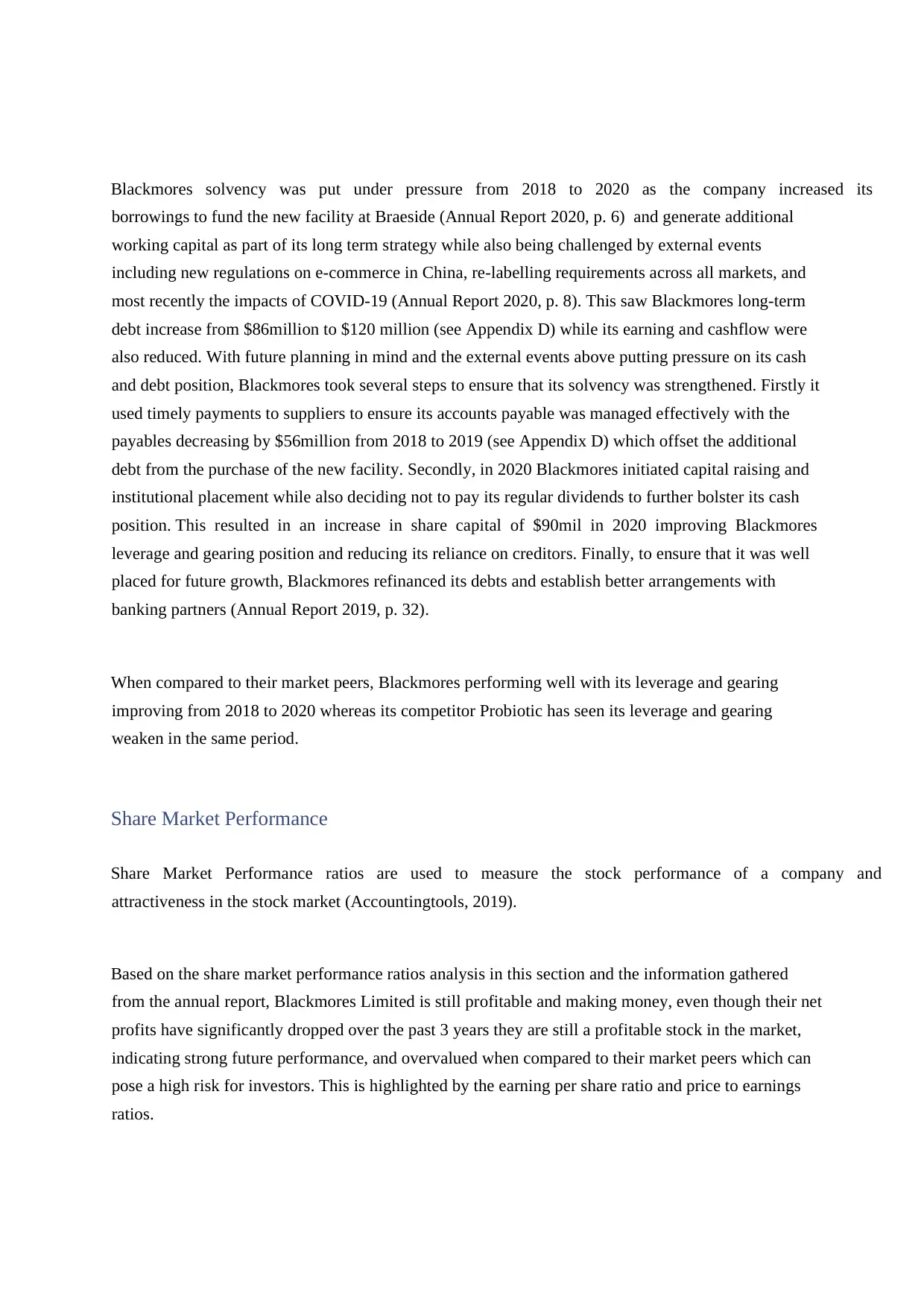
Blackmores solvency was put under pressure from 2018 to 2020 as the company increased its
borrowings to fund the new facility at Braeside (Annual Report 2020, p. 6) and generate additional
working capital as part of its long term strategy while also being challenged by external events
including new regulations on e-commerce in China, re-labelling requirements across all markets, and
most recently the impacts of COVID-19 (Annual Report 2020, p. 8). This saw Blackmores long-term
debt increase from $86million to $120 million (see Appendix D) while its earning and cashflow were
also reduced. With future planning in mind and the external events above putting pressure on its cash
and debt position, Blackmores took several steps to ensure that its solvency was strengthened. Firstly it
used timely payments to suppliers to ensure its accounts payable was managed effectively with the
payables decreasing by $56million from 2018 to 2019 (see Appendix D) which offset the additional
debt from the purchase of the new facility. Secondly, in 2020 Blackmores initiated capital raising and
institutional placement while also deciding not to pay its regular dividends to further bolster its cash
position. This resulted in an increase in share capital of $90mil in 2020 improving Blackmores
leverage and gearing position and reducing its reliance on creditors. Finally, to ensure that it was well
placed for future growth, Blackmores refinanced its debts and establish better arrangements with
banking partners (Annual Report 2019, p. 32).
When compared to their market peers, Blackmores performing well with its leverage and gearing
improving from 2018 to 2020 whereas its competitor Probiotic has seen its leverage and gearing
weaken in the same period.
Share Market Performance
Share Market Performance ratios are used to measure the stock performance of a company and
attractiveness in the stock market (Accountingtools, 2019).
Based on the share market performance ratios analysis in this section and the information gathered
from the annual report, Blackmores Limited is still profitable and making money, even though their net
profits have significantly dropped over the past 3 years they are still a profitable stock in the market,
indicating strong future performance, and overvalued when compared to their market peers which can
pose a high risk for investors. This is highlighted by the earning per share ratio and price to earnings
ratios.
borrowings to fund the new facility at Braeside (Annual Report 2020, p. 6) and generate additional
working capital as part of its long term strategy while also being challenged by external events
including new regulations on e-commerce in China, re-labelling requirements across all markets, and
most recently the impacts of COVID-19 (Annual Report 2020, p. 8). This saw Blackmores long-term
debt increase from $86million to $120 million (see Appendix D) while its earning and cashflow were
also reduced. With future planning in mind and the external events above putting pressure on its cash
and debt position, Blackmores took several steps to ensure that its solvency was strengthened. Firstly it
used timely payments to suppliers to ensure its accounts payable was managed effectively with the
payables decreasing by $56million from 2018 to 2019 (see Appendix D) which offset the additional
debt from the purchase of the new facility. Secondly, in 2020 Blackmores initiated capital raising and
institutional placement while also deciding not to pay its regular dividends to further bolster its cash
position. This resulted in an increase in share capital of $90mil in 2020 improving Blackmores
leverage and gearing position and reducing its reliance on creditors. Finally, to ensure that it was well
placed for future growth, Blackmores refinanced its debts and establish better arrangements with
banking partners (Annual Report 2019, p. 32).
When compared to their market peers, Blackmores performing well with its leverage and gearing
improving from 2018 to 2020 whereas its competitor Probiotic has seen its leverage and gearing
weaken in the same period.
Share Market Performance
Share Market Performance ratios are used to measure the stock performance of a company and
attractiveness in the stock market (Accountingtools, 2019).
Based on the share market performance ratios analysis in this section and the information gathered
from the annual report, Blackmores Limited is still profitable and making money, even though their net
profits have significantly dropped over the past 3 years they are still a profitable stock in the market,
indicating strong future performance, and overvalued when compared to their market peers which can
pose a high risk for investors. This is highlighted by the earning per share ratio and price to earnings
ratios.
Paraphrase This Document
Need a fresh take? Get an instant paraphrase of this document with our AI Paraphraser
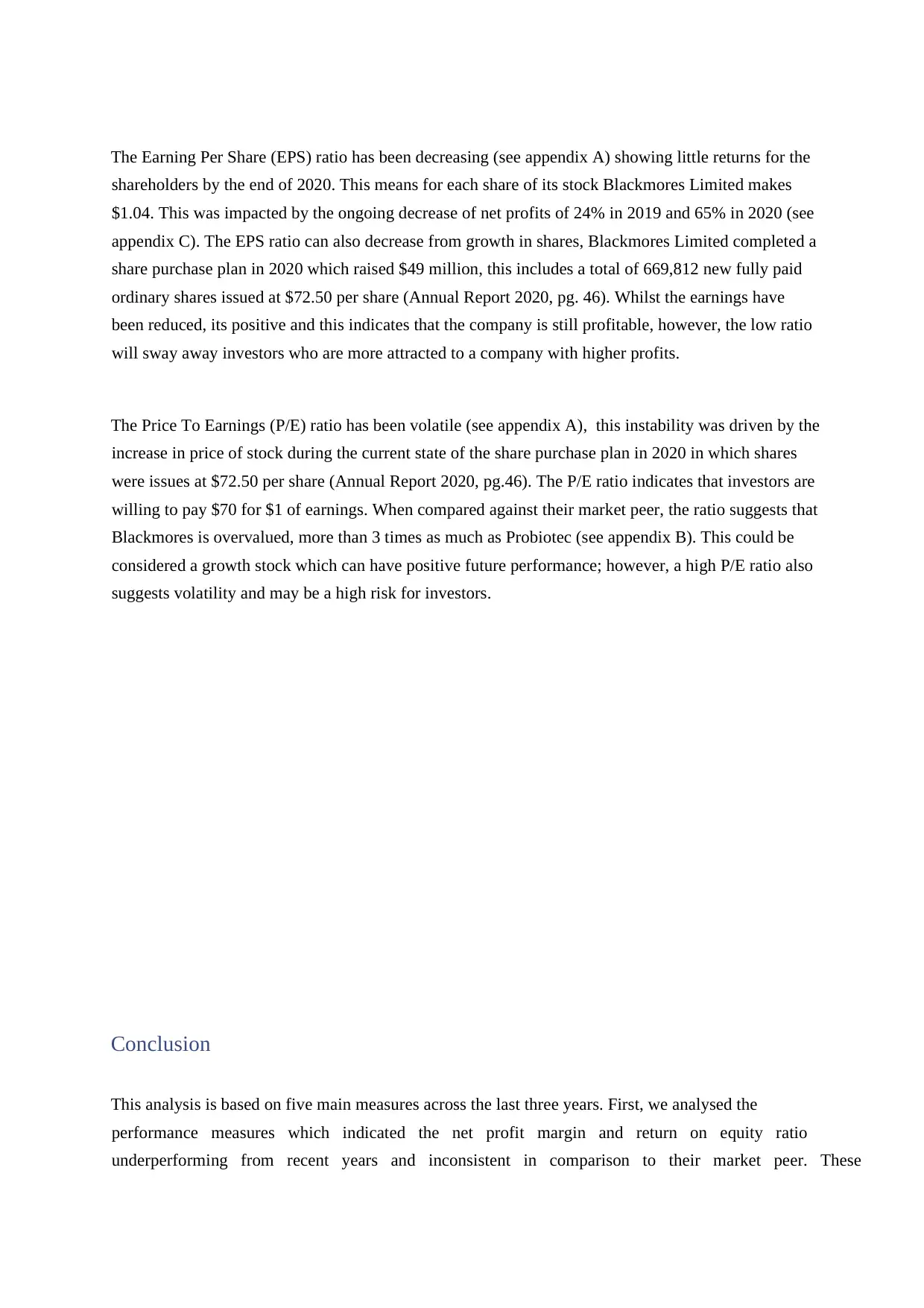
The Earning Per Share (EPS) ratio has been decreasing (see appendix A) showing little returns for the
shareholders by the end of 2020. This means for each share of its stock Blackmores Limited makes
$1.04. This was impacted by the ongoing decrease of net profits of 24% in 2019 and 65% in 2020 (see
appendix C). The EPS ratio can also decrease from growth in shares, Blackmores Limited completed a
share purchase plan in 2020 which raised $49 million, this includes a total of 669,812 new fully paid
ordinary shares issued at $72.50 per share (Annual Report 2020, pg. 46). Whilst the earnings have
been reduced, its positive and this indicates that the company is still profitable, however, the low ratio
will sway away investors who are more attracted to a company with higher profits.
The Price To Earnings (P/E) ratio has been volatile (see appendix A), this instability was driven by the
increase in price of stock during the current state of the share purchase plan in 2020 in which shares
were issues at $72.50 per share (Annual Report 2020, pg.46). The P/E ratio indicates that investors are
willing to pay $70 for $1 of earnings. When compared against their market peer, the ratio suggests that
Blackmores is overvalued, more than 3 times as much as Probiotec (see appendix B). This could be
considered a growth stock which can have positive future performance; however, a high P/E ratio also
suggests volatility and may be a high risk for investors.
Conclusion
This analysis is based on five main measures across the last three years. First, we analysed the
performance measures which indicated the net profit margin and return on equity ratio
underperforming from recent years and inconsistent in comparison to their market peer. These
shareholders by the end of 2020. This means for each share of its stock Blackmores Limited makes
$1.04. This was impacted by the ongoing decrease of net profits of 24% in 2019 and 65% in 2020 (see
appendix C). The EPS ratio can also decrease from growth in shares, Blackmores Limited completed a
share purchase plan in 2020 which raised $49 million, this includes a total of 669,812 new fully paid
ordinary shares issued at $72.50 per share (Annual Report 2020, pg. 46). Whilst the earnings have
been reduced, its positive and this indicates that the company is still profitable, however, the low ratio
will sway away investors who are more attracted to a company with higher profits.
The Price To Earnings (P/E) ratio has been volatile (see appendix A), this instability was driven by the
increase in price of stock during the current state of the share purchase plan in 2020 in which shares
were issues at $72.50 per share (Annual Report 2020, pg.46). The P/E ratio indicates that investors are
willing to pay $70 for $1 of earnings. When compared against their market peer, the ratio suggests that
Blackmores is overvalued, more than 3 times as much as Probiotec (see appendix B). This could be
considered a growth stock which can have positive future performance; however, a high P/E ratio also
suggests volatility and may be a high risk for investors.
Conclusion
This analysis is based on five main measures across the last three years. First, we analysed the
performance measures which indicated the net profit margin and return on equity ratio
underperforming from recent years and inconsistent in comparison to their market peer. These
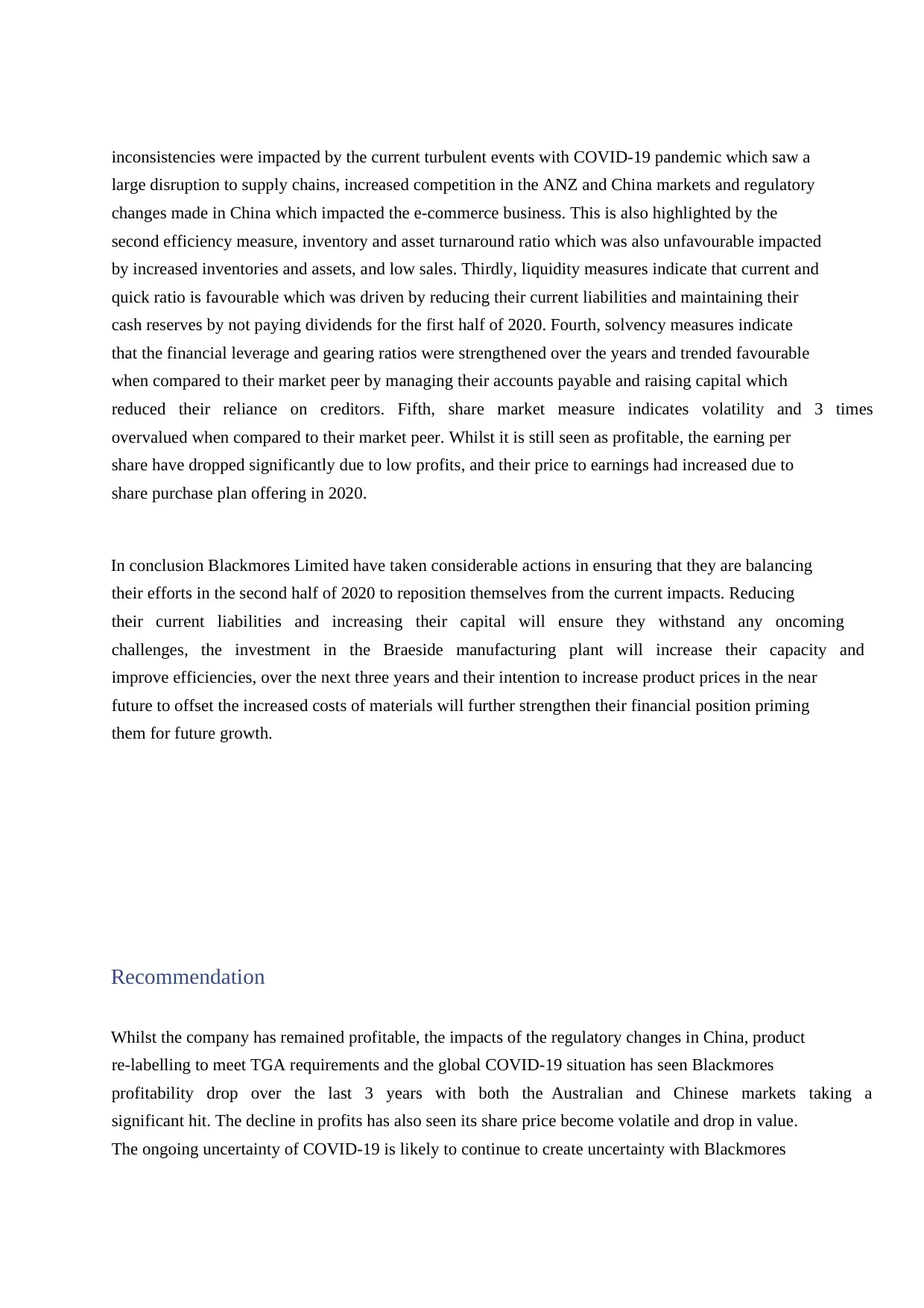
inconsistencies were impacted by the current turbulent events with COVID-19 pandemic which saw a
large disruption to supply chains, increased competition in the ANZ and China markets and regulatory
changes made in China which impacted the e-commerce business. This is also highlighted by the
second efficiency measure, inventory and asset turnaround ratio which was also unfavourable impacted
by increased inventories and assets, and low sales. Thirdly, liquidity measures indicate that current and
quick ratio is favourable which was driven by reducing their current liabilities and maintaining their
cash reserves by not paying dividends for the first half of 2020. Fourth, solvency measures indicate
that the financial leverage and gearing ratios were strengthened over the years and trended favourable
when compared to their market peer by managing their accounts payable and raising capital which
reduced their reliance on creditors. Fifth, share market measure indicates volatility and 3 times
overvalued when compared to their market peer. Whilst it is still seen as profitable, the earning per
share have dropped significantly due to low profits, and their price to earnings had increased due to
share purchase plan offering in 2020.
In conclusion Blackmores Limited have taken considerable actions in ensuring that they are balancing
their efforts in the second half of 2020 to reposition themselves from the current impacts. Reducing
their current liabilities and increasing their capital will ensure they withstand any oncoming
challenges, the investment in the Braeside manufacturing plant will increase their capacity and
improve efficiencies, over the next three years and their intention to increase product prices in the near
future to offset the increased costs of materials will further strengthen their financial position priming
them for future growth.
Recommendation
Whilst the company has remained profitable, the impacts of the regulatory changes in China, product
re-labelling to meet TGA requirements and the global COVID-19 situation has seen Blackmores
profitability drop over the last 3 years with both the Australian and Chinese markets taking a
significant hit. The decline in profits has also seen its share price become volatile and drop in value.
The ongoing uncertainty of COVID-19 is likely to continue to create uncertainty with Blackmores
large disruption to supply chains, increased competition in the ANZ and China markets and regulatory
changes made in China which impacted the e-commerce business. This is also highlighted by the
second efficiency measure, inventory and asset turnaround ratio which was also unfavourable impacted
by increased inventories and assets, and low sales. Thirdly, liquidity measures indicate that current and
quick ratio is favourable which was driven by reducing their current liabilities and maintaining their
cash reserves by not paying dividends for the first half of 2020. Fourth, solvency measures indicate
that the financial leverage and gearing ratios were strengthened over the years and trended favourable
when compared to their market peer by managing their accounts payable and raising capital which
reduced their reliance on creditors. Fifth, share market measure indicates volatility and 3 times
overvalued when compared to their market peer. Whilst it is still seen as profitable, the earning per
share have dropped significantly due to low profits, and their price to earnings had increased due to
share purchase plan offering in 2020.
In conclusion Blackmores Limited have taken considerable actions in ensuring that they are balancing
their efforts in the second half of 2020 to reposition themselves from the current impacts. Reducing
their current liabilities and increasing their capital will ensure they withstand any oncoming
challenges, the investment in the Braeside manufacturing plant will increase their capacity and
improve efficiencies, over the next three years and their intention to increase product prices in the near
future to offset the increased costs of materials will further strengthen their financial position priming
them for future growth.
Recommendation
Whilst the company has remained profitable, the impacts of the regulatory changes in China, product
re-labelling to meet TGA requirements and the global COVID-19 situation has seen Blackmores
profitability drop over the last 3 years with both the Australian and Chinese markets taking a
significant hit. The decline in profits has also seen its share price become volatile and drop in value.
The ongoing uncertainty of COVID-19 is likely to continue to create uncertainty with Blackmores
⊘ This is a preview!⊘
Do you want full access?
Subscribe today to unlock all pages.

Trusted by 1+ million students worldwide
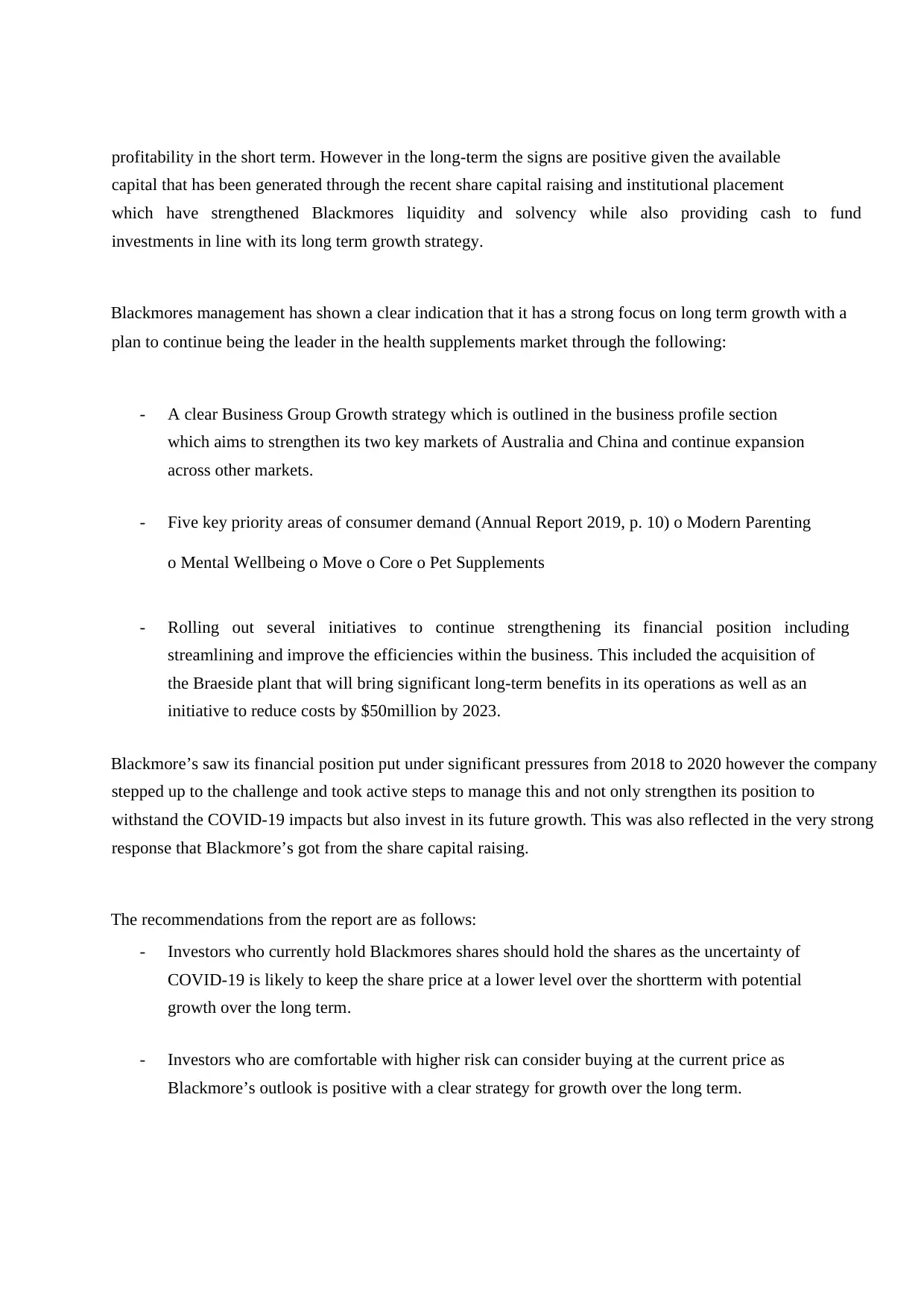
profitability in the short term. However in the long-term the signs are positive given the available
capital that has been generated through the recent share capital raising and institutional placement
which have strengthened Blackmores liquidity and solvency while also providing cash to fund
investments in line with its long term growth strategy.
Blackmores management has shown a clear indication that it has a strong focus on long term growth with a
plan to continue being the leader in the health supplements market through the following:
- A clear Business Group Growth strategy which is outlined in the business profile section
which aims to strengthen its two key markets of Australia and China and continue expansion
across other markets.
- Five key priority areas of consumer demand (Annual Report 2019, p. 10) o Modern Parenting
o Mental Wellbeing o Move o Core o Pet Supplements
- Rolling out several initiatives to continue strengthening its financial position including
streamlining and improve the efficiencies within the business. This included the acquisition of
the Braeside plant that will bring significant long-term benefits in its operations as well as an
initiative to reduce costs by $50million by 2023.
Blackmore’s saw its financial position put under significant pressures from 2018 to 2020 however the company
stepped up to the challenge and took active steps to manage this and not only strengthen its position to
withstand the COVID-19 impacts but also invest in its future growth. This was also reflected in the very strong
response that Blackmore’s got from the share capital raising.
The recommendations from the report are as follows:
- Investors who currently hold Blackmores shares should hold the shares as the uncertainty of
COVID-19 is likely to keep the share price at a lower level over the shortterm with potential
growth over the long term.
- Investors who are comfortable with higher risk can consider buying at the current price as
Blackmore’s outlook is positive with a clear strategy for growth over the long term.
capital that has been generated through the recent share capital raising and institutional placement
which have strengthened Blackmores liquidity and solvency while also providing cash to fund
investments in line with its long term growth strategy.
Blackmores management has shown a clear indication that it has a strong focus on long term growth with a
plan to continue being the leader in the health supplements market through the following:
- A clear Business Group Growth strategy which is outlined in the business profile section
which aims to strengthen its two key markets of Australia and China and continue expansion
across other markets.
- Five key priority areas of consumer demand (Annual Report 2019, p. 10) o Modern Parenting
o Mental Wellbeing o Move o Core o Pet Supplements
- Rolling out several initiatives to continue strengthening its financial position including
streamlining and improve the efficiencies within the business. This included the acquisition of
the Braeside plant that will bring significant long-term benefits in its operations as well as an
initiative to reduce costs by $50million by 2023.
Blackmore’s saw its financial position put under significant pressures from 2018 to 2020 however the company
stepped up to the challenge and took active steps to manage this and not only strengthen its position to
withstand the COVID-19 impacts but also invest in its future growth. This was also reflected in the very strong
response that Blackmore’s got from the share capital raising.
The recommendations from the report are as follows:
- Investors who currently hold Blackmores shares should hold the shares as the uncertainty of
COVID-19 is likely to keep the share price at a lower level over the shortterm with potential
growth over the long term.
- Investors who are comfortable with higher risk can consider buying at the current price as
Blackmore’s outlook is positive with a clear strategy for growth over the long term.
Paraphrase This Document
Need a fresh take? Get an instant paraphrase of this document with our AI Paraphraser
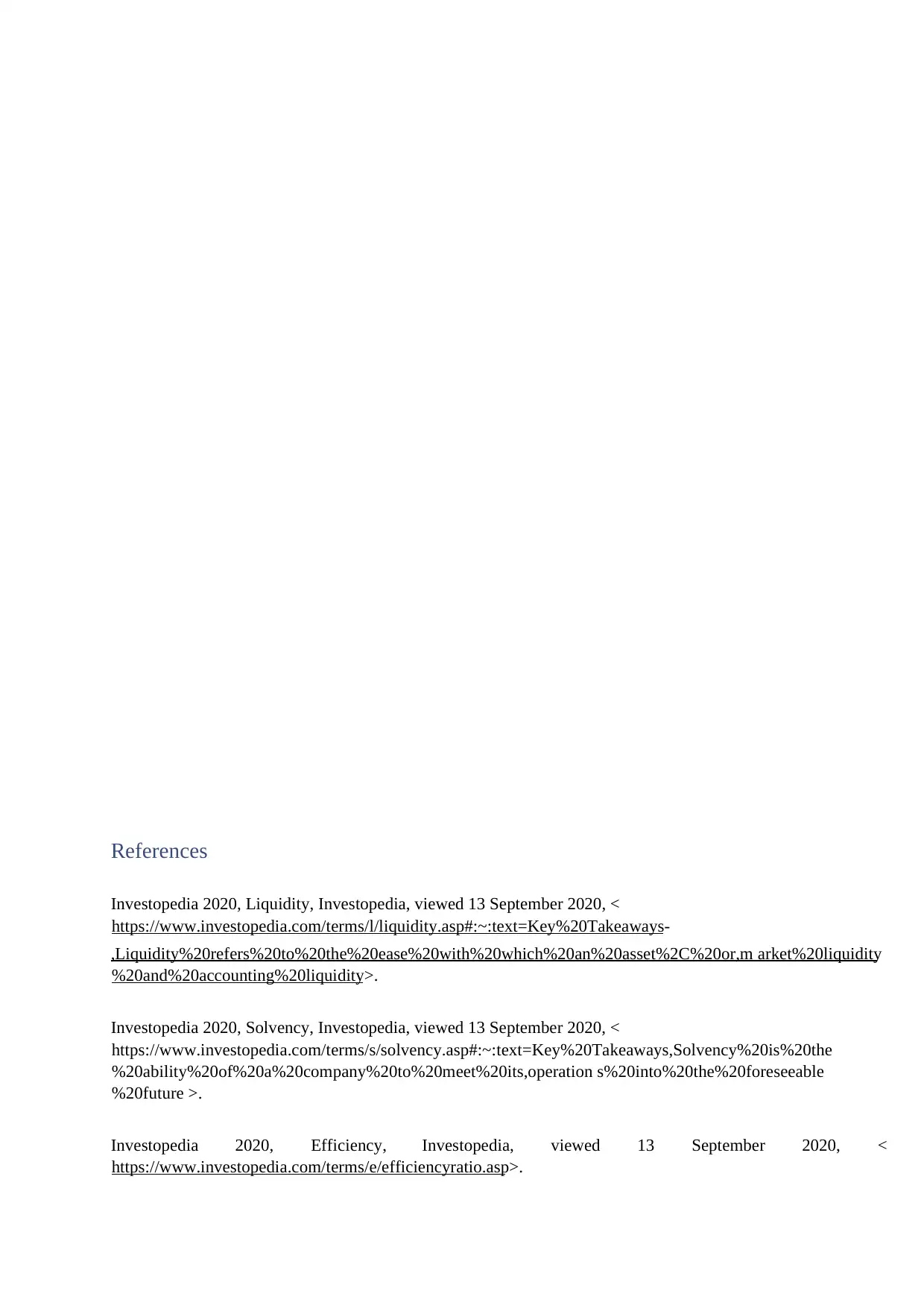
References
Investopedia 2020, Liquidity, Investopedia, viewed 13 September 2020, <
https://www.investopedia.com/terms/l/liquidity.asp#:~:text=Key%20Takeaways-
,Liquidity%20refers%20to%20the%20ease%20with%20which%20an%20asset%2C%20or,m arket%20liquidity
%20and%20accounting%20liquidity>.
Investopedia 2020, Solvency, Investopedia, viewed 13 September 2020, <
https://www.investopedia.com/terms/s/solvency.asp#:~:text=Key%20Takeaways,Solvency%20is%20the
%20ability%20of%20a%20company%20to%20meet%20its,operation s%20into%20the%20foreseeable
%20future >.
Investopedia 2020, Efficiency, Investopedia, viewed 13 September 2020, <
https://www.investopedia.com/terms/e/efficiencyratio.asp>.
Investopedia 2020, Liquidity, Investopedia, viewed 13 September 2020, <
https://www.investopedia.com/terms/l/liquidity.asp#:~:text=Key%20Takeaways-
,Liquidity%20refers%20to%20the%20ease%20with%20which%20an%20asset%2C%20or,m arket%20liquidity
%20and%20accounting%20liquidity>.
Investopedia 2020, Solvency, Investopedia, viewed 13 September 2020, <
https://www.investopedia.com/terms/s/solvency.asp#:~:text=Key%20Takeaways,Solvency%20is%20the
%20ability%20of%20a%20company%20to%20meet%20its,operation s%20into%20the%20foreseeable
%20future >.
Investopedia 2020, Efficiency, Investopedia, viewed 13 September 2020, <
https://www.investopedia.com/terms/e/efficiencyratio.asp>.
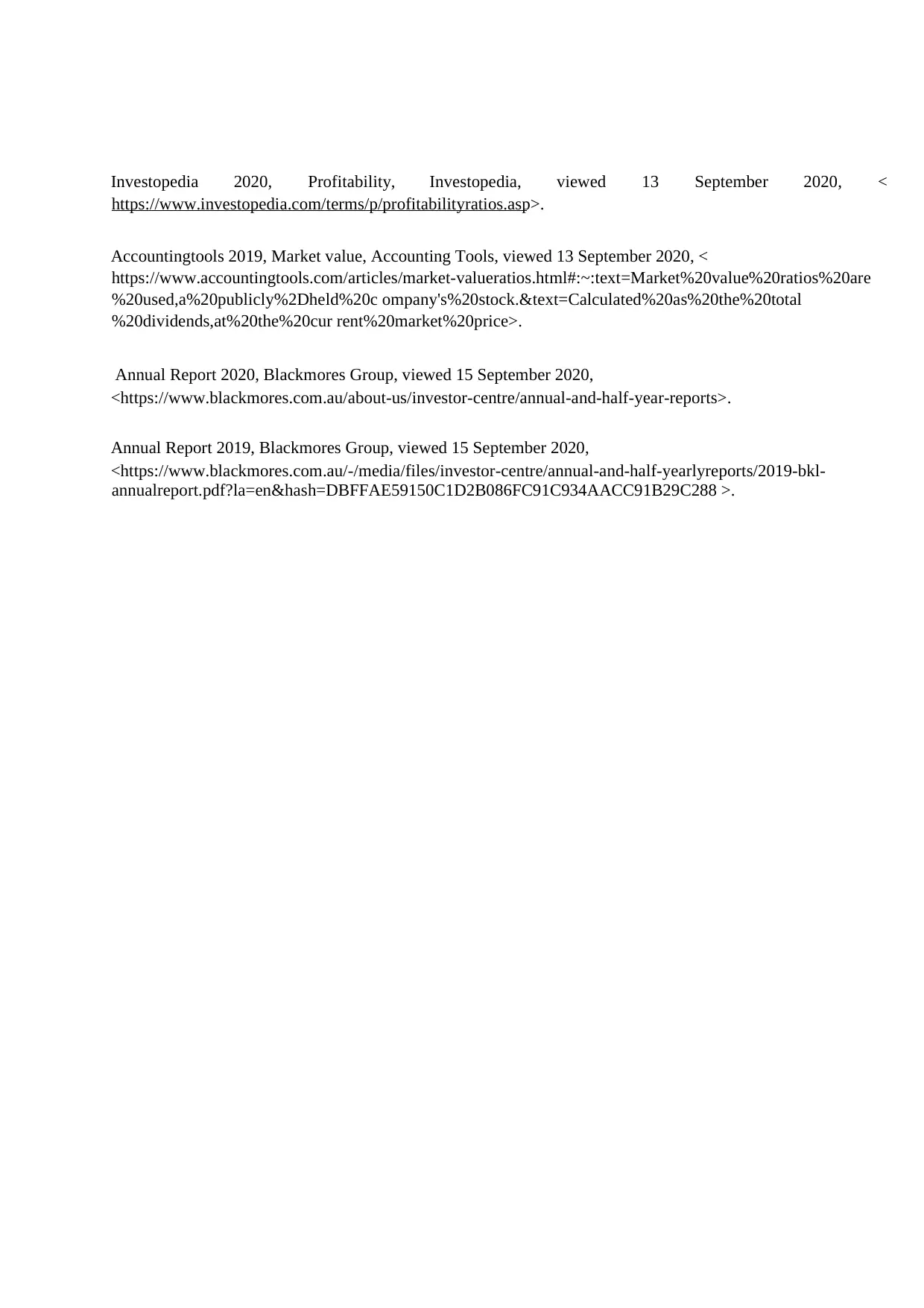
Investopedia 2020, Profitability, Investopedia, viewed 13 September 2020, <
https://www.investopedia.com/terms/p/profitabilityratios.asp>.
Accountingtools 2019, Market value, Accounting Tools, viewed 13 September 2020, <
https://www.accountingtools.com/articles/market-valueratios.html#:~:text=Market%20value%20ratios%20are
%20used,a%20publicly%2Dheld%20c ompany's%20stock.&text=Calculated%20as%20the%20total
%20dividends,at%20the%20cur rent%20market%20price>.
Annual Report 2020, Blackmores Group, viewed 15 September 2020,
<https://www.blackmores.com.au/about-us/investor-centre/annual-and-half-year-reports>.
Annual Report 2019, Blackmores Group, viewed 15 September 2020,
<https://www.blackmores.com.au/-/media/files/investor-centre/annual-and-half-yearlyreports/2019-bkl-
annualreport.pdf?la=en&hash=DBFFAE59150C1D2B086FC91C934AACC91B29C288 >.
https://www.investopedia.com/terms/p/profitabilityratios.asp>.
Accountingtools 2019, Market value, Accounting Tools, viewed 13 September 2020, <
https://www.accountingtools.com/articles/market-valueratios.html#:~:text=Market%20value%20ratios%20are
%20used,a%20publicly%2Dheld%20c ompany's%20stock.&text=Calculated%20as%20the%20total
%20dividends,at%20the%20cur rent%20market%20price>.
Annual Report 2020, Blackmores Group, viewed 15 September 2020,
<https://www.blackmores.com.au/about-us/investor-centre/annual-and-half-year-reports>.
Annual Report 2019, Blackmores Group, viewed 15 September 2020,
<https://www.blackmores.com.au/-/media/files/investor-centre/annual-and-half-yearlyreports/2019-bkl-
annualreport.pdf?la=en&hash=DBFFAE59150C1D2B086FC91C934AACC91B29C288 >.
⊘ This is a preview!⊘
Do you want full access?
Subscribe today to unlock all pages.

Trusted by 1+ million students worldwide
1 out of 21
Related Documents
Your All-in-One AI-Powered Toolkit for Academic Success.
+13062052269
info@desklib.com
Available 24*7 on WhatsApp / Email
![[object Object]](/_next/static/media/star-bottom.7253800d.svg)
Unlock your academic potential
Copyright © 2020–2025 A2Z Services. All Rights Reserved. Developed and managed by ZUCOL.




